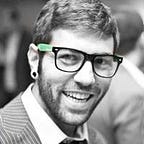Montreal’s first wearables hackathon
During the past weekend, we were part of Montreal’s first hackathon for smart wearables, Wearhacks. First of all, thanks to the organizer, I must say that it was pretty good for a first time (heat much though!).
We had the chance to build an amazing team made of web and mobile developers and an amazing designer. As usual, when we go to a hackathon, we typically meet one or two times before to discuss the project we’d like to go for. This time, our brainstorming sessions weren’t so succesful and we arrived at the hackathon without a concrete idea. The main idea was to make a “smart” city by exploiting beacons and other wearables to improve quality of life of people.
Arrived on Friday, we learned that we had to pitch our idea in order to be able to enter the competition. Without any preparation, we pitched a general idea and went on with it. Saturday, the first official day of work, started badly. We had two teams exploring solutions with both the Myo and the MetaWear. The rest we’re trying to figure out how we would use those for an app. At about 2–3 PM, the team moral was pretty low as we didn’t have anything concrete and we couldn’t agree and focus on an idea. We discussed and brainstormed some more to finally decide to stick to what we’re good at, building products. An idea of using the wearables to help people recover from injuries had been one of our options. We decided to polish the idea and go with it. That’s when Recover was born.
Having a versatile team, we decided to build a platform where physiotherapists can connect with their patients and give them exercices. The idea was to give them a quick access to statistics but also to push exercices to the people they helped. On the other hand, the patients have an application that gives them feedback while doing their exercices. We also thought of using gamification in order to get patients to enjoy doing their exercices and thus, raising their success rate.
Since we had wasted a lot of time brainstorming and playing around with the wearables, we didn’t have time to waste and started working on the different aspect of the platform. One team was building the backend with Parse. This allowed us enough flexibility and was really quick to setup. The database was fairly simple except for the exercice data which consisted of an array of points in space. Another team was building a simple web frontend that would allow physiotherapists to log in and follow their patients recovery. We also had extra time to do a landing page with all the designs and how the application should work ;).
On the other side, we had a few guys working on the iOS application. By the end of day 1, backend and frontend were almost done, most of the work left was design and the application.
The following day, we had until about 2–3 PM to completely finish and polish the iOS app. The rest of the team were working on the pitch and testing. In the end, we were able to build a prototype of a platform that has drawn enough interest to make finalist as the “Best health application”. Here’s a GIF of what our awesome designer made us do during the weekend:
As usual, the experience was amazing and we met awesome people throughout the weekend. Congratulations to all the winning teams, checkout Techvibes’ post about it. Our good friends at Tanios that joined our team also wrote a blog post about it Looking forward to the next hackathon and also, to bringing Recover to the next level.
